< Introducing Western France
Where to Eat
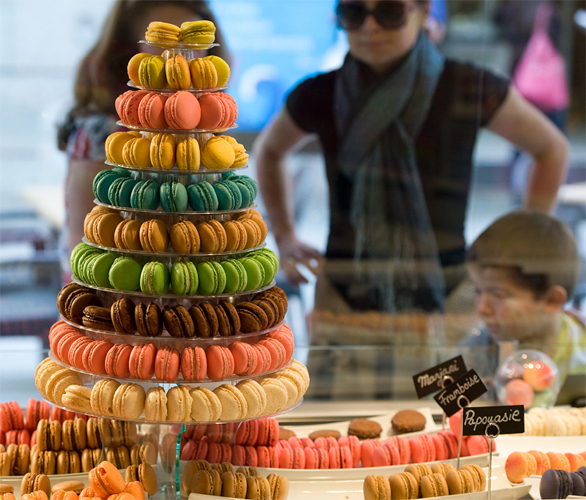
Ten tiers of tempting macaroons in a pâtisserie window
Recognized for its cultural heritage by UNESCO and renowned internationally, French cuisine offers a flavourful experience. Families travelling with children can choose from a variety of family-friendly places, from gourmet restaurants to quick and easy snack bars, cheerful bistros or pleasant roadside cafés. Even the fussiest kids will enjoy the many sweet delights on offer. Remember to try the classic specialities from each region; ask locally for suggestions.
Restaurant basics
The French keep fairly strict dining hours: lunch is served from noon to 1:30pm and dinner from 7:30 to 9pm. In some cases, especially in the countryside, those arriving after 1pm may not be served. Once you have sat down and ordered, you can eat unhurriedly and stay as long as you like, but you need to plan on arriving at a restaurant close to midday. It is a good idea to reserve a table, especially at more popular or upmarket places, and definitely at weekends. Most restaurants close at least one day a week, and finding a place to eat on a Sunday night or Monday can be difficult.
In French restaurants, the full menu is la carte, which is always expensive, whereas a menu is a set, fixed-price lunch or dinner with a more limited choice of two, three or four courses; a formule is similar, but usually suggests a cheaper, simpler menu that is often available only for weekday lunches. Simpler restaurants also often have a dish of the day (plat du jour) chalked up on a blackboard (ardoise) for lunch. Many simpler restaurants and brasseries also offer mixed salads (salades composées).
Most French restaurants have an excellent wine list (carte des vins). A bottle of water can also be ordered with the meal: gazeuse is sparkling, and plat is flat. Asking for tap water (carafe d’eau) is also acceptable; it is safe and served free. Service and tax are included in the bill (l’addition), but if the service has been good, it is customary to leave a little extra tip.
Regional specialities
One of the great joys of travelling in France is discovering the dishes and cuisine special to each region. Kids are sure to enjoy the journey too. In the west, try the pâtés and tarte tatins (apple pies) of the Loire Valley, or the galettes (savoury buckwheat pancakes) and shellfish in Brittany.
Eating out with kids
Most restaurants in France welcome children, but few will have highchairs, so consider taking a portable one for very young kids. French kids are well behaved and are treated as adults in restaurants; running about is not appreciated. Make sure kids do not disturb the other patrons.
An economical children’s menu (menu enfant) – two or three courses in kid-sized portions, often specified for “under 10s” – is often on offer. Classic entries include steak haché (burger without the bun), chicken or ham with frites (chips) or spaghetti bolognese and ice cream. Or ask for a portion enfant, a scaled-down version of food on the regular menu. Since French dinner hours may be too late for young kids, brasseries that serve meals all day are always a good bet for an earlier meal.
Cafés, bistros or restaurants with outdoor seating tend to be ideal for families, offering some distractions for squirmy children. The menus are always posted outside, so check that there is something for everyone in the family before sitting. There is no dearth of fast-food chains such as McDonalds, Buffalo Grill and the French hamburger outlet Quick, while bakeries, sandwicheries and kebab stands offer a range of kid-friendly food (pizza slices, pies and quiches). Present in all towns, cafés offer hot chocolate, fruit juices (jus de fruit) and sirops (fruit-flavoured syrups mixed with water) to choose from.
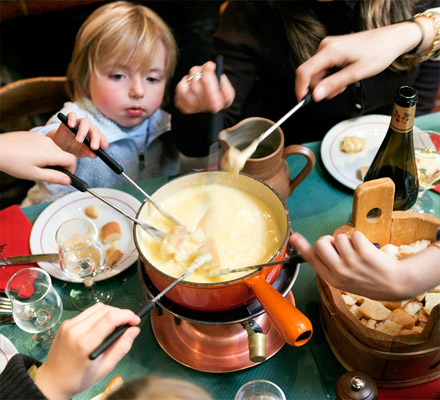
Using long-stemmed forks to dip bread into cheese fondue
Shopping for food
French markets (
marchés) are a feast for the senses and fun to visit. Cities have at least one covered market (
halle); most are open daily except on Mondays. Towns and villages will have one or more weekly outdoor market days and often farmers’ markets selling organic produce (
bio). See also
Shopping.
Supermarkets (supermarchés or hypermarchés) sell all types of foods and drinks, but the French treasure their traditional shops too, especially bakeries (boulangeries), which bake breads and croissants, and pastry shops (pâtisseries). Meats can be bought from a butcher shop (boucherie). Supermarkets usually also have a type of delicatessen (traiteur) that sells prepared meat and seafood dishes, as well as salads. Smaller villages have a family-run grocer (épicerie) or a convenience store, such as Vidal, Proxi or Casino.
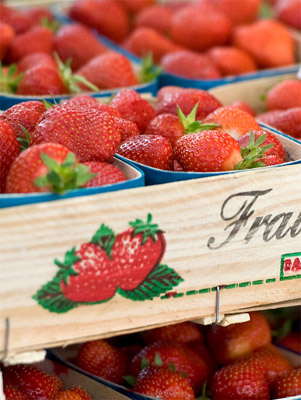
Farm-fresh strawberries (fraises) for sale at a local market stall
Kids’ Corner
Taste-bud feast
If you have watched the cartoon Ratatouille, you already know that French food is the best in the world. Even if there is something you do not like at home, always remember, in France they often cook it differently. Try a little bite of everything – you never know, you may change your mind!
French dishes that get the thumbs up from many kids:
-
Tartiflette a baked dish with potatoes, cheese and ham
-
Croque monsieur a grilled ham and cheese open sandwich
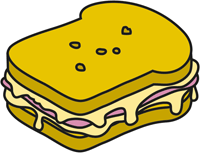
-
Confit de carnard golden crispy duck leg, usually served with sautéed potatoes
-
Quiche Lorraine an egg, ham and cheese tart
-
Cordon bleu boneless chicken breast baked with ham and cheese inside
-
Raclette boiled potatoes, ham and saucisson (thick, dry cured sausage) drowned in melted cheese. Everyone around the table mixes together their own combination.
-
Fondue this can be a main course or a dessert – food (bread, beef, or strawberries) on sticks, fried in oil or dipped in something warm (usually melted cheese in France).
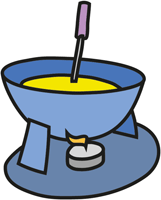
-
Crêpes thin pancakes filled with cheese, ham, chocolate, or just sugar and lemon – the possibilities are endless!
-
Glace ice cream (cornet: cone; coupe: cup)

Wishing and eating
In Provence, it is traditional to serve 13 desserts at Christmas. Some are very simple (fruit or nuts), but it is customary to have a taste of each one and then make a wish.






